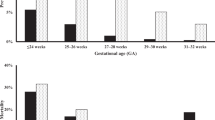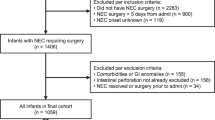Abstract
Objective
To assess incidence and effect of delayed diagnosis of spontaneous intestinal perforation (SIP).
Study design
Retrospective case series review of 58 VLBW neonates with SIP at our institution.
Result
SIP was diagnosed in 6.1%, 10%, and 15.1% of VLBW, ELBW, and ≤750 g neonates, respectively. Abdominal distension (58.6%) and abdominal discoloration (53.4%) were the most common presenting signs/symptoms. Smaller (≤750 g) neonates were more likely to present with hypotension and higher FiO2, and larger (751–1500 g) neonates with increased abdominal girth and abdominal distension. All but one neonate had radiographic pneumoperitoneum, and 25.9% had pneumoperitoneum on an X-ray prior to the X-ray at SIP diagnosis. An education module reduced delay in SIP diagnosis.
Conclusion
SIP presentation varies by birth weight and gestational age. Since SIP diagnosis is often first suggested on X-ray, all X-rays of VLBW neonates in the first 2 weeks of life should be scrutinized for pneumoperitoneum.
This is a preview of subscription content, access via your institution
Access options
Subscribe to this journal
Receive 12 print issues and online access
$259.00 per year
only $21.58 per issue
Buy this article
- Purchase on Springer Link
- Instant access to full article PDF
Prices may be subject to local taxes which are calculated during checkout


Similar content being viewed by others
References
Attridge JT, Herman AC, Gurka MJ, Griffin MP, McGahren ED, Gordon PV. Discharge outcomes of extremely low birth weight infants with spontaneous intestinal perforations. J Perinatol. 2006;26(1):49–54.
Donahue L, Trotter C. Spontaneous intestinal perforation. Neonatal Netw. 2007;26(5):335–351.
Gordon P, Rutledge J, Sawin R, Thomas S, Woodrum D. Early postnatal dexamethasone increases the risk of focal small bowel perforation in extremely low birth weight infants. J Perinatol. 1999;19(8 Part1):573–577.
Tatekawa Y, Muraji T, Imai Y, Nishijima E, Tsugawa C. The mechanism of focal intestinal perforations in neonates with low birth weight. Pediatr Surg Int. 1999;15(8):549–552.
Pumberger W, Mayr M, Kohlhauser C, Weninger M. Spontaneous localized intestinal perforation in very-low-birth-weight infants: a distinct clinical entity different from necrotizing enterocolitis. J Am Coll Surg. 2002;195(6):796–803.
Okuyama H, Kubota A, Oue T, Kuroda S, Ikegami R, Kamiyama M. A comparison of the clinical presentation and outcome of focal intestinal perforation and necrotizing enterocolitis in very-low-birth-weight neonates. Pediatr Surg Int. 2002;18(8):704–706.
Holland AJ, Shun A, Martin HC, Cooke-Yarborough C, Holland J. Small bowel perforation in the premature neonate: congenital or acquired? Pediatr Surg Int. 2003;19(6):489–94.
Gordon PV. Understanding intestinal vulnerability to perforation in the extremely low birth weight infant. Pediatr Res. 2009;65(2):138–144.
Jakaitis BM, Bhatia AM. Definitive peritoneal drainage in the extremely low birth weight infant with spontaneous intestinal perforation: predictors and hospital outcomes. J Perinatol. 2015;35(8):607–611.
Aschner JL, Deluga KS, Metlay LAS, Emmens RW, Hendricks-Munoz KD. Spontaneous focal gastrointestinal perforation in very low birth weight infants. J Pediatr. 1988;113(2):364–367.
Anderson MS, Johnson CB, Townsend SF, Hay WH. Enteral nutrition. In: Merenstein GB, Gardner SL, editors. Handbook of neonatal intensive care, 8th ed. St. Louis, Missouri: Mosby Inc; 2015. p. 377–418.
Carter BM. Feeding intolerance in preterm infants and standard of care guidelines for nursing assessments. Newborn Infant Nurs Rev. 2012;12(4):187–201.
Gordon P, Christensen R, Weitkamp JH, Maheshwari A. Mapping the new world of necrotizing enterocolitis (NEC): review and opinion. EJ Neonatol Res. 2012;2(4):145–172.
Vermont Oxford Network Database. Manual of Operations, Release 22.1. Burlington, VT: Vermont Oxford Network Database; 2017. p. 42–43.
Levine MS, Scheiner JD, Rubesin SE, Laufer I, Herlinger H. Diagnosis of pneumoperitoneum on supine abdominal radiographs. Am J Roentgenol. 1991;156(4):731–735.
Farrugia MK, Morgan AS, McHugh K, Kiely EM. Neonatal gastric perforation. Arch Dis Child Fetal Neonatal Ed. 2003;88(1):75.
Kasznia-Brown J, Cook C. Radiological signs of pneumoperitoneum: a pictorial review. Br J Hosp Med. 2006;67(12):634–639.
Raturi S, Chandran S, James TEH, Rajadurai VS. Radiological signs of pneumoperitoneum in an extremely low birthweight infant. BMJ Case Rep. 2014. https://doi.org/10.1136/bcr-2014-205510.
Sureka B, Bansal K, Arora A. Pneumoperitoneum: what to look for in a radiograph. J Fam Med Prim Care. 2015;4(3):477–478.
Shah J, Singhal N, da Silva O, Rouvinez-Bouali N, Seshia M, Lee SK, et al. Intestinal perforation in very preterm neonates: risk factors and outcomes. J Perinatol. 2015;35(8):595–600.
Doyle LW, Cheong JL, Ehrenkranz RA, Halliday HL. Early (<8 days) systemic postnatal corticosteroids for prevention of bronchopulmonary dysplasia in preterm infants. Cochrane Database Syst Rev. 2017;10:CD001146.
Blakely ML, Lally KP, McDonald S, Brown R, Barnhart DC, Ricketts RR, et al. Postoperative outcomes of extremely low birth-weight infants with necrotizing enterocolitis or isolated intestinal perforation: a prospective cohort study by the NICHD neonatal research. Ann Surg. 2005;241(6):984–994.
Fisher JG, Jones BA, Gutierrez IM, Hull MA, Horng Kang K, Kenny M, et al. Mortality associated with laparotomy-confirmed neonatal spontaneous intestinal perforation: a prospective 5-year multicenter analysis. J Pediatr Surg. 2014;49(8):1215–1219.
Sola JE, Tepas JJ 3rd, Koniaris LG. Peritoneal drainage versus laparotomy for necrotizing enterocolitis and intestinal perforation: a meta-analysis. J Surg Res. 2010;161(1):95–100.
Wadhawan R, Oh W, Hintz SR, Blakely ML, Das A, Bell EF, et al. Neurodevelopmental outcomes of extremely low birth weight infants with spontaneous intestinal perforation or surgical necrotizing enterocolitis. J Perinatol. 2014;34(1):64–70.
Meldere I, Urtans V, Petersons A, Abola Z. Measurement of abdominal circumference in preterm infants. BMC Res Notes. 2015;8:725.
Jaile JC, Levin T, Wung JT, Abramson SJ, Ruzal-Shapiro C, Berdon WE. Benign gaseous distension of the bowel in premature infants treated with nasal continuous airway pressure: a study of contributing factors. Am J Roentgenol. 1992;158(1):125–127.
Garland JS, Nelson DB, Rice T, Neu J. Increased risk of gastrointestinal perforations in neonates mechanically ventilated with either face mask or nasal prongs. Pediatrics. 1985;76(3):406–410.
Kim J. “Blowing up” the CPAP belly myth. 2018. http://blog.neonatalperspectives.com/2018/01/11/blowing-up-the-cpap-belly-myth/.
Goldstein RF, Thompson RJ, Oehler JM, Brazy JE. Influence of acidosis, hypoxemia, and hypotension on neurodevelopmental outcome in very low birth weight infants. Pediatrics. 1995;95(2):238–243.
Seri I. Management of hypotension and low systemic blood flow in the very low birth weight infant during the first postnatal week. J Perinatol. 2006;26(suppl):S8–13.
Batton B, Zhu X, Fanaroff J, Kirchner HL, Berlin S, Wilson-Costello D, et al. Blood pressure, anti-hypotensive therapy, and neurodevelopment in extremely preterm infants. J Pediatr. 2009;154(3):351–357.
Hyginus EO, Jideoffor U, Victor M, N OA. Gastrointestinal perforation in neonates: aetiology and risk factors. J Neonatal Surg. 2013;2(3):30.
McBride WJ, Roy S, Brudnicki A, Stringel G. Correlation of complex ascites with intestinal gangrene and perforation in neonates with necrotizing enterocolitis. J Pediatr Surg 2010;45(5):887–889.
Bell MJ, Ternberg JL, Feigin RD, Keating JP, Marshall R, Barton L, et al. Neonatal necrotizing enterocolitis. Therapeutic decisions based upon clinical staging. Ann Surg 1978;187(1):1–7.
Leonidas JC, Hall RT, Rhodes PG, Amoury RA. Pneumoperitoneum in ventilated newborns: a medical or a surgical problem? Am J Dis Child. 1974;128(5):677–680.
Gummalla P, Mundakel G, Agaronov M, Lee H. Pneumoperitoneum without intestinal perforation in a neonate: case report and literature review. Case Rep Pediatr. 2017;2017:6907329.
Author information
Authors and Affiliations
Contributions
DJK collected and analyzed the data, drafted the initial paper, and approved the final paper. SG, RN (and neonatal nurse practitioner in training), collected and analyzed the data, helped draft the initial paper, and approved the final paper. JSW analyzed the data, revised the paper, and approved the final paper. PDF analyzed the data, revised the paper, and approved the final paper.
Corresponding author
Ethics declarations
Conflict of interest
The authors declare that they have no conflict of interest.
Additional information
Publisher’s note: Springer Nature remains neutral with regard to jurisdictional claims in published maps and institutional affiliations.
Supplementary information
Rights and permissions
About this article
Cite this article
Kahn, D.J., Gregorisch, S., Whitehouse, J.S. et al. Delayed diagnosis of spontaneous intestinal perforation among very low birth weight neonates: A single center experience. J Perinatol 39, 1509–1520 (2019). https://doi.org/10.1038/s41372-019-0480-0
Received:
Revised:
Accepted:
Published:
Issue Date:
DOI: https://doi.org/10.1038/s41372-019-0480-0



